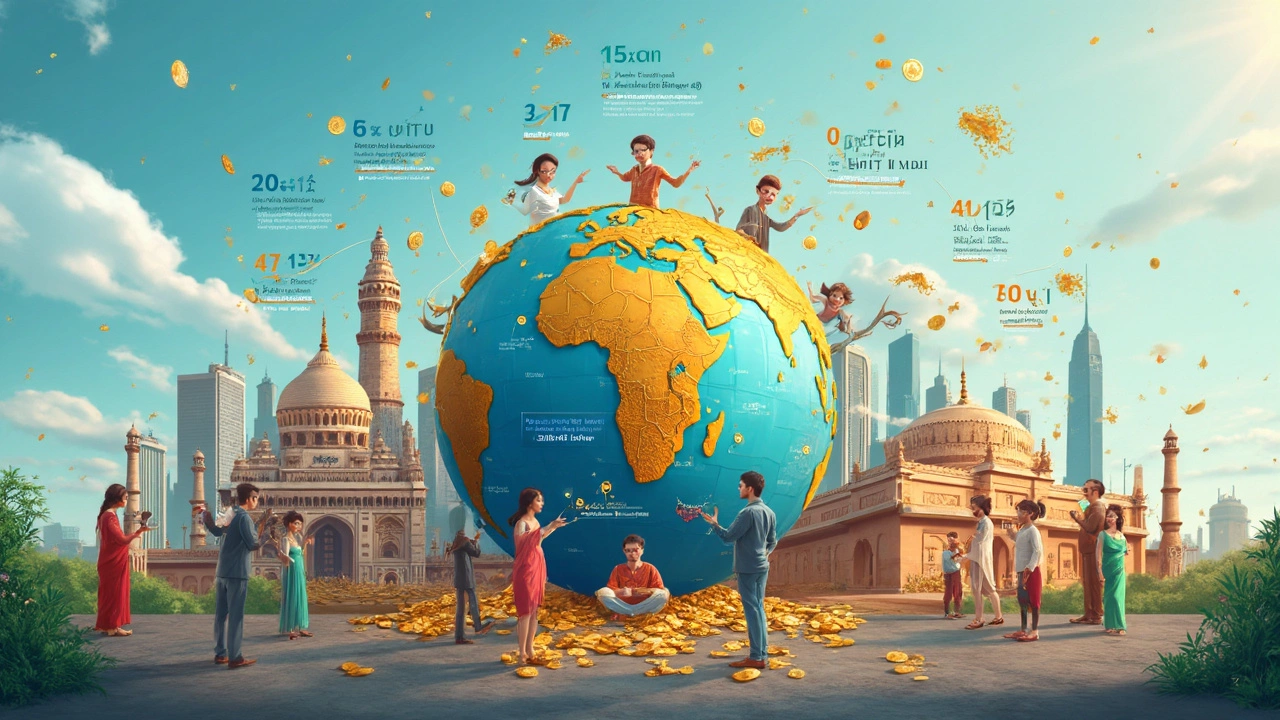Forget what you’ve heard at family gatherings—being the richest country isn’t about gold or how flashy the skyline looks. The answer really depends on how you measure wealth. You’ll hear a lot about GDP—basically, how much money a country produces in a year. But if you just look at the total, the biggest countries always win. That’s not fair, right?
So, experts usually talk about GDP per capita—fancy talk for “how much money does the average person in this country make?” This way, a small country with very rich residents can shoot to the top. If you’ve ever stumbled across stories about countries with high-paid bankers or zero income tax, you’re not far off.
Knowing which country is the richest isn’t just for winning trivia night. It tells us a lot about how people live there. Higher wealth usually means better schools, hospitals, and jobs. But it can mask some serious problems, like the gap between the super-rich and everyone else. Sound familiar?
- How Do We Measure a Country’s Wealth?
- World’s Richest Country Right Now
- Where Does India Stand?
- How Can You Use This Info in Daily Life?
How Do We Measure a Country’s Wealth?
People love to argue about which country is the richest, but they rarely agree on how to measure it. The classic go-to is GDP (Gross Domestic Product), which is just the total value of everything a country makes and does in one year. But if you only look at GDP, giant countries like the US or China always take the top spot—just because there are so many people.
That’s why economists talk about GDP per capita. This number takes the whole GDP and divides it by how many people live in the country, showing how much the average person could have if the wealth were split up evenly. Here’s how it works:
- GDP per capita = GDP ÷ Population
This is the number most folks check when ranking countries for wealth. A tiny place like Luxembourg with tons of banks and a small population beats big countries simply because there’s more money going around for each person.
"GDP per capita gives us a sense of people’s living standards, not just a country’s economic power." — World Bank Financial Inclusion Specialist, 2023
Of course, there are other ways to check a country’s wealth, like looking at:
- Median income: Shows what most people actually earn—sometimes more honest than averages.
- Human Development Index (HDI): Mixes income with health and education data.
- Household wealth: Considers property, savings, and investments—not just salaries.
Here’s a quick look at how some countries rank by GDP per capita (2024, in US dollars):
| Rank | Country | GDP per Capita (USD) |
|---|---|---|
| 1 | Luxembourg | 132,370 |
| 2 | Ireland | 114,580 |
| 3 | Switzerland | 101,430 |
| 4 | Norway | 89,030 |
| 5 | Singapore | 88,450 |
Sounds simple, but remember: super-high GDP per capita doesn’t mean everyone there is loaded. Some countries just have a few people with loads of cash—and a whole lot of it tied up in finance or oil. So next time someone tosses out the list of richest countries, dig a bit deeper and ask—rich for who, exactly?
World’s Richest Country Right Now
If you’re curious about who’s topping the charts, Luxembourg grabs the spotlight as the world’s richest country by GDP per capita. This place is tiny—smaller than some Indian cities—but the average person in Luxembourg makes more money than people pretty much anywhere else. According to the International Monetary Fund (IMF), Luxembourg’s GDP per capita is around $130,000 USD in 2024. That’s huge, especially when you think most countries don’t even reach $50,000.
Why is Luxembourg so loaded? It isn’t just luck. This tiny European country has a strong banking sector, friendly tax rules, and tons of international businesses choosing to set up shop there. On top of that, a lot of people who work in Luxembourg actually live in neighboring countries and commute, which keeps average income figures high.
Other countries usually found near the top are Switzerland, Ireland, Norway, and Singapore. These places aren’t giant, but they have clever economic tricks—like smart tax rates or a focus on specialized industries—that keep national incomes high.
But here’s the thing most people miss: these numbers are averages. Just because a country is rich on paper doesn’t mean every person there is living the high life. There can still be people struggling, even in the world’s richest nations. So, when you’re comparing places, it’s worth looking at these details—and not just chasing big numbers.

Where Does India Stand?
Let’s get real—if you look at the world’s richest country by GDP per capita, India isn’t near the top. According to the International Monetary Fund (IMF) and World Bank data from 2024, India’s GDP per capita is still on the lower side, hanging around $2,800 (USD) per year. That’s a far cry from places like Luxembourg, which crosses $130,000 per person. But here’s the thing: India’s total economy is huge. In fact, India jumped into the top five largest economies by total GDP, thanks to its massive population and steady growth.
Here’s a quick look at how India compares with other countries in 2024:
| Country | GDP per Capita (USD) | Total GDP (Trillion USD) |
|---|---|---|
| Luxembourg | ~$133,000 | ~$0.09 |
| United States | ~$85,000 | ~$28 |
| China | ~$12,700 | ~$19.5 |
| India | ~$2,800 | ~$4.2 |
So why does this matter? Even though India isn’t listed among the world’s richest by individual income, its entire economy is a powerhouse. Tech, manufacturing, and services are pushing India forward fast. A growing middle class and millions moving out of poverty every year give hope for more improvements.
And if you’re wondering about everyday life, it really depends on where you are in India. Big cities like Mumbai or Bengaluru have booming tech hubs, luxury shopping, and world-class hospitals. But life is way harder in smaller towns and rural villages, with limited access to great schools, basic services, and steady jobs. The gap is wide, but things are inching forward.
If you’re an Indian living abroad, you might notice people still ask, "Wow, so many billionaires in India?" It’s true—India is home to several super-rich. But for most people, daily life is about making steady progress, one step at a time.
How Can You Use This Info in Daily Life?
So, why even care about which is the richest country? It’s more than just a fun fact. Knowing how countries build wealth (and the things that actually work) can help you plan your own steps to a better lifestyle, whether you’re in India or anywhere else.
For example, countries with top rankings usually focus on strong education, healthcare, and ease of doing business. Take Singapore—they made education a priority and now their students top global charts. Qatar, the richest by GDP per person as of 2024, boosted its wealth by investing in natural gas while making sure locals benefit from those earnings.
Here’s a quick look at what common features the highest-ranked countries share, according to 2024 data:
| Country | Main Source of Wealth | Life Expectancy (years) |
|---|---|---|
| Qatar | Natural Gas, Oil | 80 |
| Luxembourg | Banking, Finance | 82 |
| Singapore | Trade, Tech, Finance | 84 |
| Norway | Oil, Welfare State | 83 |
What can someone in India actually do with this info? Here's how you can use it for your own benefit:
- Invest in Learning: The world’s richest countries pump money into education and skills. Look for free online courses or job training—there are plenty for Indians, whether you're into tech, finance, or language learning.
- Health Matters: Countries with high life expectancy make healthcare a top priority. Check if your company provides health insurance or look at affordable plans locally—it's a long-term investment.
- Business Mindset: Ease of starting a business is a huge advantage. In India, online registrations and UPI have made things easier than ever; think about side gigs or freelance work.
- Keep Track of Trends: Smart countries adapt to new industries like AI and green energy. Find areas where you can upskill or invest, even if it's at a small level.
Bottom line? The stats aren’t just numbers—they’re a window into strategies that work. Take them, tweak them, and use them to level up your own life wherever you are.
